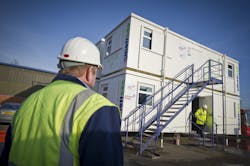Since the construction industry began to rebound in 2013, demand for modular off-site construction has increased. Between 2014 and 2017, the market is estimated to have progressed by 26% and is set to grow another 4% per year from 2018 to 2020. This encouraging uptick can be attributed to recovery in sectors such as offices and education along with increased demand for site accommodation on infrastructure projects.
Developers, architects and builders are all becoming aware of the myriad benefits offered by technological innovations within the modular industry for all sorts of construction projects – from hotels to eco-friendly homes and a new generation of office buildings. As a long-lasting and often favourable alternative to on-site building, modular construction offers flexibility and quality, along with delivery schedule and budget guarantees. The modular industry is also leading the way when it comes to boosting sustainability and limiting environmental impact.
Quality as standard
Providing quality service to accompany quality products is a modular building provider’s number one priority. The off-site construction model produces components of a more consistent quality thanks to standardised processes and training. Components also undergo multiple checks – when they leave the factory and again on the construction site. As a result, modular buildings meet and often exceed quality expectations and safety requirements.
Speed and savings
Another result of using off site assembled modules, ready-equipped with the latest electrical and plumbing systems and complete with high-end finishes, is reduced lead times. Building components are produced in a controlled environment, where delays due to inclement weather, theft of materials, and sub-contractor absence are virtually eliminated. Furthermore, the use of the latest technology for taking accurate measurements practically eliminates the potential margin for error present with traditional construction methods. Modular building providers can bring in projects on time and budget. By eliminating delays and reducing the number of highly skilled workers required for a project, off-site construction methods allow clients to manage their budget and make substantial cost savings.
Modular: Green in Nature
Reducing our environmental footprint is one of the most pressing issues of our time, and no architect, developer or builder can plan a construction project without taking into account the environmental impact of the building and the building process. Production of components in an enclosed indoor environment allows modular buildings to meet the requirements of green building certifications such as the Building Research Establishment Environmental Assessment Method or BREEAM. This sets the best practice standards for the environmental performance of buildings through design, specification, construction and operation. Off-site methods also reduce material waste in the factory and on site, and since modular accommodation is often more tightly built, occupiers can benefit from greater energy efficiency and the resulting cost savings.
Energy efficiency for energy supplier
In December 2016, energy giant Centrica took environmental responsibility very seriously when they started a major offshore wind farm project in Lincolnshire. Keen to be as green as possible, they chose to hire energy-efficient portable buildings to reduce electricity and water consumption. They hired 14 eco-cabins from locally implanted national supplier Elliott, which were installed in a double-stacked formation at the plant in compliance with rigorous safety standards. These eco-conscious buildings provided a range of green features, including double-glazed windows, improved wall and roof insulation, PIR lighting, and thermostatically controlled heating. The cabins were initially used to provide offices and welfare accommodation for the temporary workforce for a six-week period during a plant shutdown.
Sponsored by:

